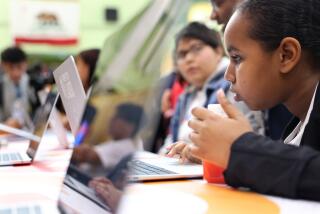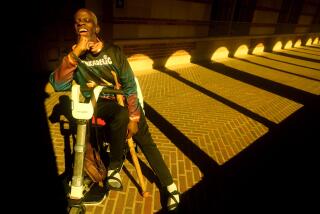Disabled Computer Users Aided : Technology: Researchers at Cal State Northridge have worked 1 1/2 years on a way to allow students to use virtually any system they can sit in front of.
A paralyzed college student could use the same computer as his classmates. A blind architect could work with the same computer graphics program as his colleagues. A disabled person could operate an automated teller machine with his laptop computer.
Until now, such people have been anchored to one computer specially equipped for their needs. On Tuesday, researchers at Cal State Northridge unveiled technology that allows the disabled to use virtually any computer they sit in front of.
“It gives them the opportunity to be competitive instead of always trying to catch up with nondisabled people,” said Neil Scott, a technology specialist at the university. “It gives them freedom.”
Scott and his co-workers have spent the last 1 1/2 years developing the Universal Access System at CSUN, where more than 1,000 disabled students are enrolled. They said it will be available to the public in about a year.
“A computer doesn’t know that the user is disabled. A computer doesn’t care,” said Harry Murphy, director of the school’s Office of Disabled Student Services. “If the disabled person can get to it and make it work, educational opportunities are vastly improved, job opportunities are vastly improved.”
Over the last decade, the personal computer has been a great liberator for disabled people. The blind can listen to computers that talk in synthesized voices. People without the use of their hands can tell a computer what to do by speaking into a microphone. Those who can’t speak can tap Morse code or blow puffs of air into a straw to give commands.
But the sophisticated systems have been incompatible with the vast majority of computers in schools and workplaces.
The Universal Access System will change all that, Scott said, by employing two relatively low-cost and portable components:
First, the disabled person can purchase a laptop computer with programs and equipment that adapt to his disability. These additions might include a screen that enlarges printed words for the visually impaired.
Second, this specialized setup can be linked to another computer by using two transmitter-receivers, each the size of a small transistor radio, that work something like a television remote control. The matching links talk to each other in infrared signals.
The system can be used with nearly all computers and software, including graphics programs in which the disabled user can tell the cursor what to draw.
David Clark, a UC Berkeley student who has cerebral palsy, has been working with Scott on a personalized system. They are developing a computer roughly the size of a videocassette that attaches to Clark’s wheelchair. He wears a hard hat outfitted with a microphone and a one-inch computer screen that flips down in front of his left eye--a device straight out of Star Wars.
When Clark wheels up to another computer, his infrared link automatically begins talking to that computer’s link. The main computer screen is reproduced on the easy-to-use eye screen. He commands the computer simply by speaking into his microphone.
“I’m not a fast typist at all, but I know what I’m doing,” Clark said. “What this will allow me to do is work on my Macintosh at home, go to the library and do a library search, then go to work and do stuff on my computer at work.”
Toddlers could use the system to pick out computer pictures of food they want to eat. And the infrared technology could be adapted for use with home appliances or automated tellers.
The links will sell for between $100 and $200 each, compared with the $5,000 it can cost to adapt a single computer, Scott said.
“Here at Cal State Northridge, we’re particularly proud of our reputation in the area of educating disabled students,” President James W. Cleary said. He called the Universal Access System a historical development and “the greatest educational phenomenon that this institution has witnessed.”







